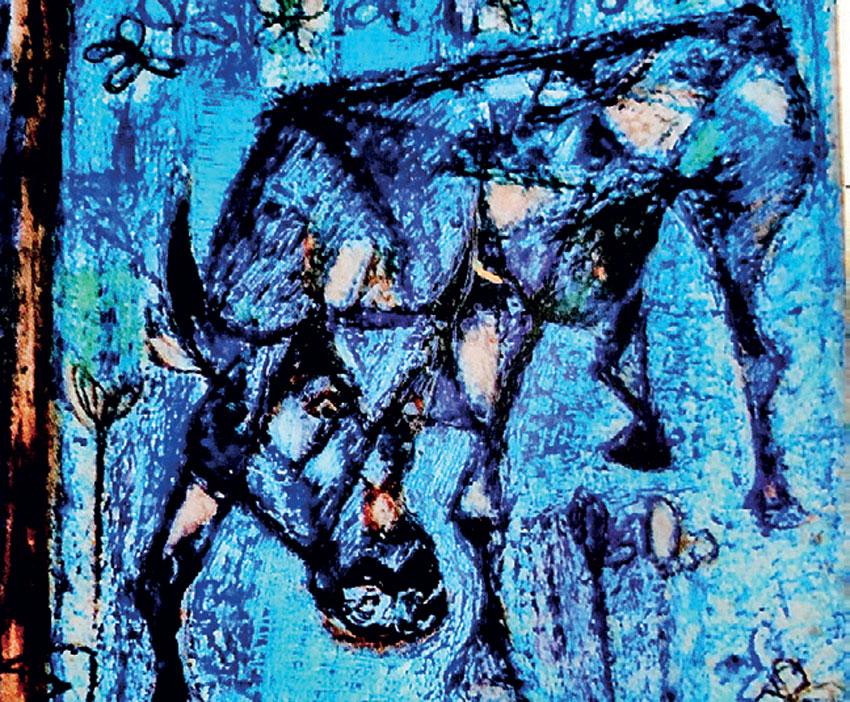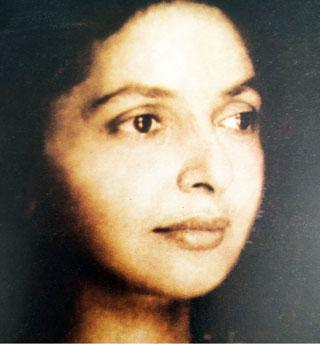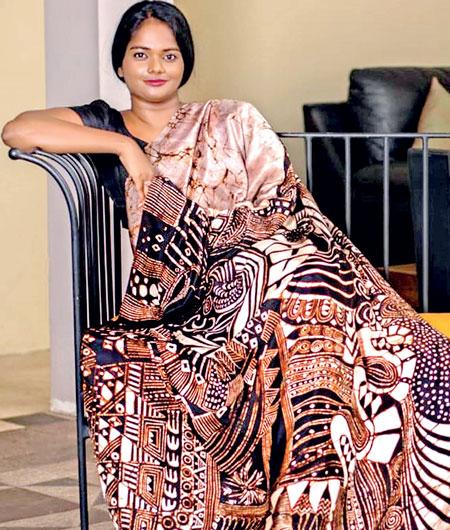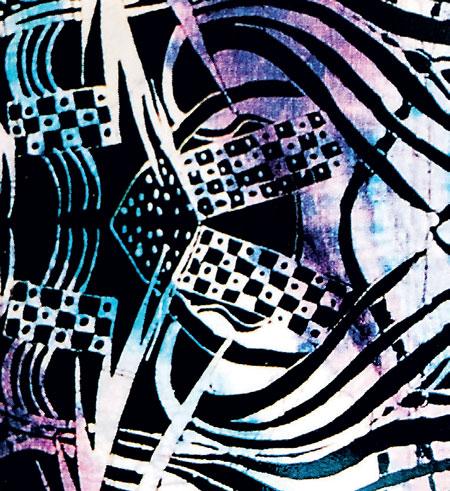22 Apr 2023 - {{hitsCtrl.values.hits}}

 The 60’s was a time when our country had one of its greatest periods of artistic creativity. The 43 Group which was formed decades earlier had paved the way for yet another generation of artists and designers who broke the mold and took Sri Lankan art and design to a position from which it was instantly recognisable as something that was uniquely our own. Ceylon had indeed carved its place in the world of art with the emergence of the giants who consisted of the initial 43 Group, and this was ably supported by a set of budding artists who followed their footsteps many years later. This younger generation matched their skills equally and excelled by moving into the other realms of creativity such as sculpture, handlooms, theatre, film, architecture, batiking and fashion design.
The 60’s was a time when our country had one of its greatest periods of artistic creativity. The 43 Group which was formed decades earlier had paved the way for yet another generation of artists and designers who broke the mold and took Sri Lankan art and design to a position from which it was instantly recognisable as something that was uniquely our own. Ceylon had indeed carved its place in the world of art with the emergence of the giants who consisted of the initial 43 Group, and this was ably supported by a set of budding artists who followed their footsteps many years later. This younger generation matched their skills equally and excelled by moving into the other realms of creativity such as sculpture, handlooms, theatre, film, architecture, batiking and fashion design.
 For those who aren’t aware, the '43 Group was a 20th-century modern art group established in August 1943 in Ceylon. This group was essentially an association of like-minded artists who had broken away from the Ceylon Society of Arts. They were led by photographer and critic Lionel Wendt and originally included nine painters as key members: Geoffery Beling, George Claessan Aubrey Collette, Justin Daraniyagala, Richard Gabriel, George Keyt, Ivan Peries, Harry Pieris (the first and only Secretary of the Group), and the Ven. Manjusri Thero. The group were influenced by Charles Freegrove Winzer to whom Keyt and Beling had been pupils. The paintings by this group constituted a historic break in Sri Lankan and more generally, South Asian traditions of painting.
For those who aren’t aware, the '43 Group was a 20th-century modern art group established in August 1943 in Ceylon. This group was essentially an association of like-minded artists who had broken away from the Ceylon Society of Arts. They were led by photographer and critic Lionel Wendt and originally included nine painters as key members: Geoffery Beling, George Claessan Aubrey Collette, Justin Daraniyagala, Richard Gabriel, George Keyt, Ivan Peries, Harry Pieris (the first and only Secretary of the Group), and the Ven. Manjusri Thero. The group were influenced by Charles Freegrove Winzer to whom Keyt and Beling had been pupils. The paintings by this group constituted a historic break in Sri Lankan and more generally, South Asian traditions of painting.
What members of the 43 Group held in common was not a style but a conviction that Ceylonese art could be modern without sacrificing the values and traditions of our island. They showed that Ceylonese life, and values, with its deep roots in ancient tradition, could be portrayed in a twentieth century manner. Their works created an atmosphere of confidence, which opened the eyes of many who realised that there was such a thing as modern Ceylonese art and gave them the license to be creative with it.
 Many younger artists who were inspired by the 43 Group were incorporated and accepted by them because they showed similar convictions to the thinking behind this particular creative process. This marked the start of the Young Artists Group whose creativity extended beyond that of painting. A few of them with interests and talents in the arts tried new and unprecedented things and had remarkable, far-reaching success in such areas as designing handlooms, weaving, applique, tie-dye and creating fashion accessories. Chiefly among them was the remarkably talented Swanee Jayawardene.
Many younger artists who were inspired by the 43 Group were incorporated and accepted by them because they showed similar convictions to the thinking behind this particular creative process. This marked the start of the Young Artists Group whose creativity extended beyond that of painting. A few of them with interests and talents in the arts tried new and unprecedented things and had remarkable, far-reaching success in such areas as designing handlooms, weaving, applique, tie-dye and creating fashion accessories. Chiefly among them was the remarkably talented Swanee Jayawardene.
Suvenithi De Mel was born on the 22 June 1930. She was a student at Good Shepherd’s Convent, Kotahena. Her passion for painting was fostered by some of the best-known art teachers of that era, namely Cora Abraham, K.S. Perera and Harry Pieris. Her progress as a recognised artist was cemented when she started exhibiting her work alongside other members of the 43 Group and this led to her paintings being shown at the Venice Biennale in 1950. She married Harold Jayawardena (a journalist and musician) and had three children. Manel, Menik and Rohan.
Even though I never had the privilege of meeting her I used to be constantly amazed at the works she exhibited on the window of her boutique on Galle Road.
Swanee had taken the art of tie-dye to new heights. She used the most unusual colour combinations to tie and dye fabrics and then she batiked over it. This unique innovation, aptly named ‘Explosion batiks’ by the creator herself, were an absolute sensation!
 Swanee taught art at Bishops College Colombo for a period of 19 years. At the time the new Bishop’s College auditorium opened, her former pupils officially requested that some of her paintings were displayed in the foyer. She donated as many as 25 of her vibrant and colourful paintings which used to adorn the walls on the new hall making it look rather like a retrospective of her work. Some of her pieces were even hung along the dressing room corridors. These were an inspiration to the younger generations who looked at them in awe. Mysteriously, none of them seem to be around anymore!
Swanee taught art at Bishops College Colombo for a period of 19 years. At the time the new Bishop’s College auditorium opened, her former pupils officially requested that some of her paintings were displayed in the foyer. She donated as many as 25 of her vibrant and colourful paintings which used to adorn the walls on the new hall making it look rather like a retrospective of her work. Some of her pieces were even hung along the dressing room corridors. These were an inspiration to the younger generations who looked at them in awe. Mysteriously, none of them seem to be around anymore!
Then there were those amazing fashion shows that displayed Swanee’s creations, vividly. The supermodels of yesteryear Tamara Subramaniam, Mano and Vidya Wanigesooriya and Akushala Selliah and many more, wowed us with stunningly beautiful outfits all of which were made only with local fabrics, threads and dyes. “Implosion” a fashion show curated and choreographed by Swanee’s younger daughter Menik has stayed in my mind ever since I saw it because of its sheer, bold and audacious use of colour!
At the start of her creative life, Swanee worked mostly at home and started selling whatever she made from there itself. The overwhelming demand for her products meant that she had to give up her career as a teacher. It was then that she realised that opening an outlet for her creative ventures was the way to go. Her three children supported her every step of the way as their mother’s artistic genes had been inherited by them too. Her son Rohan managed the boutique until he sadly passed away. It was Rohan’s initiative and business acumen that made his mother’s products be seen all over the world. Swanee’s crafts and creations have been exhibited at several Trade Fairs all over the world including in countries such as Germany, France, Egypt, Japan the UK and many more.
When I met up with Menik recently she talked about her mother, “Amma was always working” she said to me and continued to affirm her mother’s conviction to the creative process. “From the time she came back after teaching at school, she used to put on her rubber gloves, tuck her sari pota onto her waist and keep experimenting with the dyes or she would paint”. Menik continues to create wonderfully exotic batik saris whenever she gets the chance to do so as she has clearly inherited her mother’s gift as a colourist, however, her passion is for creative dance. She remains a respected teacher in Colombo.
Manel, her elder daughter made a similar observation in an article she wrote for a programme honouring her mother by stating, “Painting was her life. It was like she lived for it.” Manel who was married to the famous theatre Director, Dhamma Jagoda, continues to be create exquisite works of pottery. Porcelain Art as her works have been termed can be found at selected boutiques in Colombo. She also creates stunning wall hangings made in the similar style as her mother’s unique applique’ work
Speaking of her late son Rohan, Swanee recalled "When my son was just five years old, and he would help me with my tie and dye. He would abandon his friends who played various games with him on the staircase of the Bambalapitiya flats and join me to hold a sari or a piece of fabric for me".
 This is proof indeed as to where her three children inherited a wealth of talent themselves. After all, one just has to glance at the extent of Swanee’s creativity to fathom the array of ideas from which one could take a leaf and expand from. Yes, she was a painter, she also created fashionable clothes mostly in tie and dye/batik. She made macrame and batik tablecloths, cushion covers, carry bags, handbags, and other accessories.
This is proof indeed as to where her three children inherited a wealth of talent themselves. After all, one just has to glance at the extent of Swanee’s creativity to fathom the array of ideas from which one could take a leaf and expand from. Yes, she was a painter, she also created fashionable clothes mostly in tie and dye/batik. She made macrame and batik tablecloths, cushion covers, carry bags, handbags, and other accessories.
Applique’ wall-hangings were another highlight of her work demonstrating the fact that nothing was ever wasted. Saris and cloth and jacket ensembles with applique work were a favourite at her very own earlier fashions shows titled “Vilasitha.” Her men’s clothing range included t-shirts, shirts, and sarongs, as were the unusual (batiked stretch fabric) leggings which were a favourite among teenage girls! She even created batik infused fibre glass tables. Her daughter Manel was instrumental in blending beeralu lace with cheese cloth and amu redi to make dresses which was quite the rage in those days. It was her son Rohan who had the brainchild of tie-dying waterproof fabrics and making umbrellas with them. All of this contributed to the uniqueness of the brand that was ‘Swanee.’

Even though most of us remember Swanee as a designer of the most exciting and exquisite fashion garments, her craft, her skill, and her love were embedded in her paintings. Many of her works that can be seen today are pieces that she created during the latter part of her life. Which makes one wonder about what happened to her earlier works? Especially the paintings done when she was moving as one with those key figures of the 43 Group. It is when those questions are asked that we realise that Swanee stopped painting from 1970 to 1977 and this was because over 400 early pieces by this great woman were collected by an unscrupulous person who promised to mount an exhibition for her, and that was the last she or anyone saw them! Devastated by this betrayal of trust her recovery was painstakingly slow, yet she gradually came out of it and painted until she passed away in 2010.
The loss of these paintings has left a yawning gap in Swanee’s legacy, which I think most Sri Lankans and her family ought to see and know about. Ceylonese artists who thrived in the mid and late 20th century are now fetching record breaking prices for their works and most of them are sold through the likes of Sotheby’s and Christie’s. Surely, Swanee’s work needs to be found, recognised, and valued simply because she was a genius of our time and quite definitely of our country.
15 Nov 2024 18 minute ago
15 Nov 2024 1 hours ago
15 Nov 2024 3 hours ago
15 Nov 2024 4 hours ago
15 Nov 2024 4 hours ago